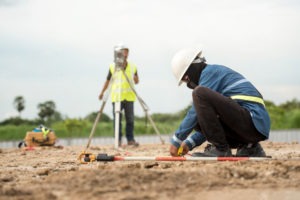
A land survey indicates a plot’s boundaries, corners, and improvements relative to its property lines. The finalized survey features a written report outlining the surveyor’s observations or concerns as well as a detailed illustration of the property’s physical features.
Does that mean all land surveys are legal documents? Land surveys are typically legally binding, and they include legal descriptions that can help property owners better understand their boundary lines.
Are All Land Surveys Legally Binding?
As long as a licensed land surveyor completes your report, your land survey is an official legal document. During the surveying process, your technician will compare historical records, fieldwork data, and existing markers to define your property’s characteristics. The surveyor then compiles everything into a finalized report, making their findings legally binding.
The completed land survey contains a legal description of your plat, allowing you and any other entity to identify your property’s location accurately. The legal description is never based on your listed address because those are sometimes incorrect. Instead, the legal description uses permanent reference points and township grids to explain the location and size of your plot.
A land survey’s legal description must be clearly defined, and all property lines must meet to form an enclosed parcel of land. There are three main types of legal descriptions used in land surveys: lot and block, metes and bounds, and fractional descriptions.
Lot and Block
Lot and block legal descriptions are commonly used when surveying subdivided properties. Surveyors create plat maps for a piece of land before developers separate it into subplots.
The map defines the exact size and boundary lines of each plot. It also notes any utilities, streets, and easements on or close to the property. Each divided lot receives an individual number, and each group of sub-plots in an adjacent lot gets a block number.
The lots and blocks describe the subdivided property, and professionals use this legal description when developing or buying a parcel of land. In addition, zoning regulators utilize lot and block legal definitions to ensure the property adheres to local codes. They also maintain that the blocks do not impede public areas, such as nearby streets or public parks.
Metes and Bounds
Metes means distance, and bounds refers to direction. Therefore, metes and bounds legal descriptions define the direction and location of a parcel of land. It is the oldest form of describing property lines, and it is primarily used in states along the east coast of the US.
The legal description includes a point of beginning (POB) where the land begins and ends (also known as a point of commencement). It defines a parcel’s border starting at the POB and defines all boundary lines until the POB is reached again.
In many cases, surveyors use a permanent monument to establish their point of beginning. Monuments are natural or artificial structures on a property line, such as a large tree or fence. The metes and bounds description will start from the monument and explain (in feet and inches) the direction of the next monument, such as a large boulder.
Fractional
Fractional legal descriptions break properties down by sections. These types of reports are best suited for square or rectangular properties.
A surveyor uses certified corner records to determine a plot’s total distance and calculate the different sections. Corner records are legal documents that denote property corners. Land surveyors use the corner records to assess the different areas of a property.
What Does a Professional Land Survey Include?
A completed land survey must include specific requirements based on the type of land survey performed. Most land surveys will consist of:
- The property’s legal description
- A street address
- Locations of any adjacent properties and buildings close to your plot’s boundary lines
- The location and description of structural improvements on the property (such as a pool)
- Any current easements
A land survey indicates a plot’s boundaries, corners, and improvements relative to its property lines. The finalized survey features a written report outlining the surveyor’s observations or concerns as well as a detailed illustration of the property’s physical features.
Does that mean all land surveys are legal documents? Land surveys are typically legally binding, and they include legal descriptions that can help property owners better understand their boundary lines.
Are All Land Surveys Legally Binding?
As long as a licensed land surveyor completes your report, your land survey is an official legal document. During the surveying process, your technician will compare historical records, fieldwork data, and existing markers to define your property’s characteristics. The surveyor then compiles everything into a finalized report, making their findings legally binding.
The completed land survey contains a legal description of your plat, allowing you and any other entity to identify your property’s location accurately. The legal description is never based on your listed address because those are sometimes incorrect. Instead, the legal description uses permanent reference points and township grids to explain the location and size of your plot.
A land survey’s legal description must be clearly defined, and all property lines must meet to form an enclosed parcel of land. There are three main types of legal descriptions used in land surveys: lot and block, metes and bounds, and fractional descriptions.
Lot and Block
Lot and block legal descriptions are commonly used when surveying subdivided properties. Surveyors create plat maps for a piece of land before developers separate it into subplots.
The map defines the exact size and boundary lines of each plot. It also notes any utilities, streets, and easements on or close to the property. Each divided lot receives an individual number, and each group of sub-plots in an adjacent lot gets a block number.
The lots and blocks describe the subdivided property, and professionals use this legal description when developing or buying a parcel of land. In addition, zoning regulators utilize lot and block legal definitions to ensure the property adheres to local codes. They also maintain that the blocks do not impede public areas, such as nearby streets or public parks.
Metes and Bounds
Metes means distance, and bounds refers to direction. Therefore, metes and bounds legal descriptions define the direction and location of a parcel of land. It is the oldest form of describing property lines, and it is primarily used in states along the east coast of the US.
The legal description includes a point of beginning (POB) where the land begins and ends (also known as a point of commencement). It defines a parcel’s border starting at the POB and defines all boundary lines until the POB is reached again.
In many cases, surveyors use a permanent monument to establish their point of beginning. Monuments are natural or artificial structures on a property line, such as a large tree or fence. The metes and bounds description will start from the monument and explain (in feet and inches) the direction of the next monument, such as a large boulder.
Fractional
Fractional legal descriptions break properties down by sections. These types of reports are best suited for square or rectangular properties.
A surveyor uses certified corner records to determine a plot’s total distance and calculate the different sections. Corner records are legal documents that denote property corners. Land surveyors use the corner records to assess the different areas of a property.
What Does a Professional Land Survey Include?
A completed land survey must include specific requirements based on the type of land survey performed. Most land surveys will consist of:
- The property’s legal description
- A street address
- Locations of any adjacent properties and buildings close to your plot’s boundary lines
- The location and description of structural improvements on the property (such as a pool)
- Any current easements
In addition, other types of land surveys may include more detailed descriptions of property features.
For example, a topographic survey features contour lines to describe changes in evaluation or terrain. But an ALTA land title survey may include underground utility locations and ancillary buildings as required by the American Land Title Association.
What Does a Legally-Binding Land Survey Do for Property Owners?
Since your professional land survey is a legal document, you can use it to settle disputes. For example, if a neighbor builds a fence that crosses your property, you can use the land survey to show encroachment. In addition, legal experts frequently use certified land surveys when settling boundary line disputes.
If you purchase a new property, a land survey can minimize risks in the real estate transaction process. The land survey legally describes the extent of your parcel of land and defines your exact boundary lines. You can refer to the legal document at any point, such as when adding new structures to your plot or selling your property.
Get a Land Survey From Your Local Pros
If you need a new or updated survey for your property, trust the experts at Scalice Land Surveying for the job. We provide fast and efficient land surveying services to New York residents. Contact us now to learn more about what our land surveying company can do for your property.
In addition, other types of land surveys may include more detailed descriptions of property features.
For example, a topographic survey features contour lines to describe changes in evaluation or terrain. But an ALTA land title survey may include underground utility locations and ancillary buildings as required by the American Land Title Association.
What Does a Legally-Binding Land Survey Do for Property Owners?
Since your professional land survey is a legal document, you can use it to settle disputes. For example, if a neighbor builds a fence that crosses your property, you can use the land survey to show encroachment. In addition, legal experts frequently use certified land surveys when settling boundary line disputes.
If you purchase a new property, a land survey can minimize risks in the real estate transaction process. The land survey legally describes the extent of your parcel of land and defines your exact boundary lines. You can refer to the legal document at any point, such as when adding new structures to your plot or selling your property.
Get a Land Survey From Your Local Pros
If you need a new or updated survey for your property, trust the experts at Scalice Land Surveying for the job. We provide fast and efficient land surveying services to New York residents. Contact us now to learn more about what our land surveying company can do for your property.



